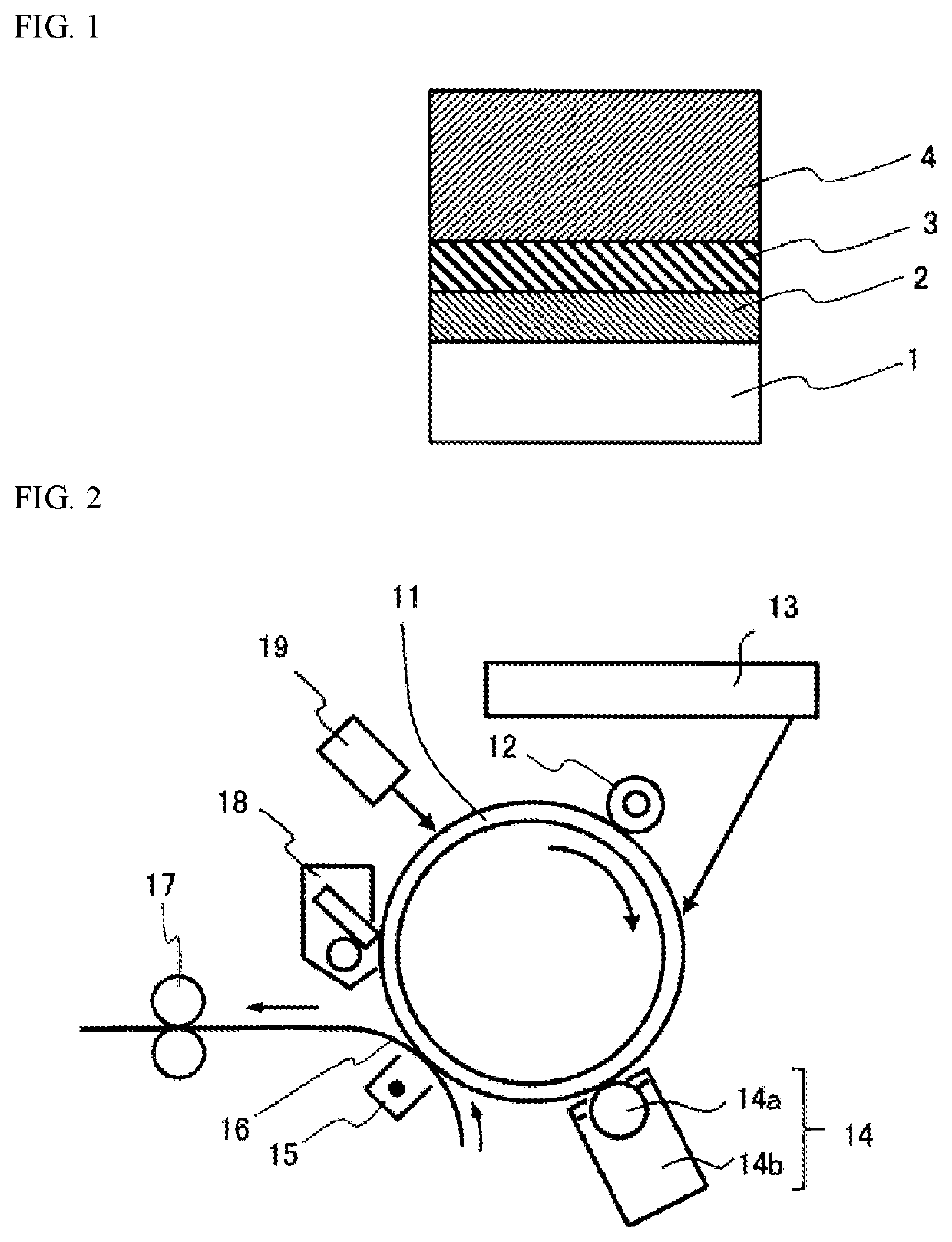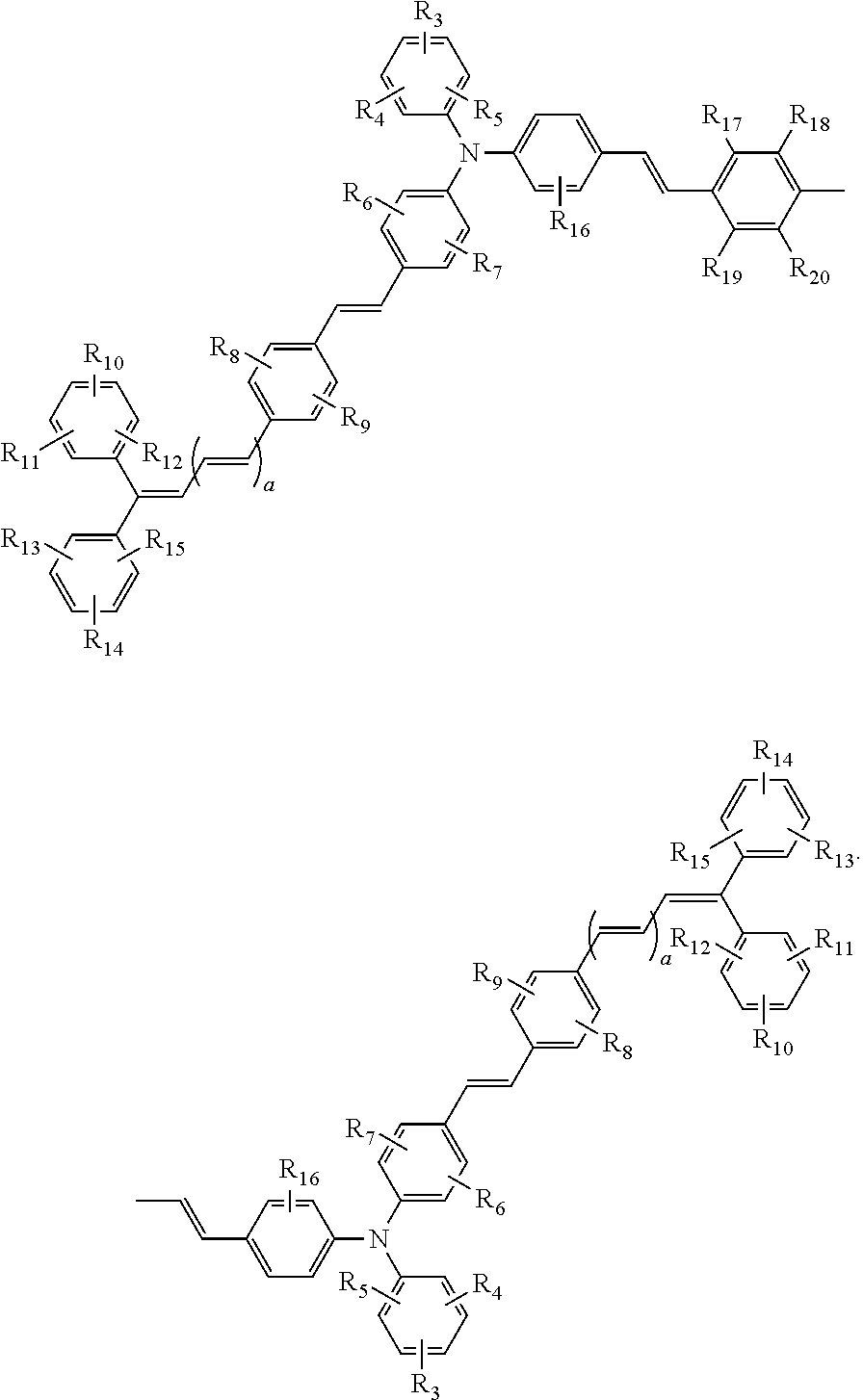Electrophotographic photoreceptor, process for producing the electrophotographic photoreceptor, and electrophotographic device
a photoreceptor and electrophotography technology, applied in the field of electrophotographic devices, can solve the problems of reducing the sensitivity, lowering the durability, and reducing the charge transport ability and sensitivity, and achieve excellent solvent resistance and crack resistance, excellent sensitivity characteristics, and excellent sensitivity characteristics
- Summary
- Abstract
- Description
- Claims
- Application Information
AI Technical Summary
Benefits of technology
Problems solved by technology
Method used
Image
Examples
example 1
[0068]Fifteen (15) parts by mass of a p-vinylphenol resin (trade name: Marukalinker MH-2, manufactured by Maruzen Petrochemical Co., Ltd.), 10 parts by mass of an N-butylated melamine resin (trade name: Uban 2021, manufactured by Mitsui Chemicals, Inc.), and 75 parts by mass of titanium oxide fine particles treated with aminosilane were dissolved or dispersed in a mixed solvent of 750 parts by mass / 150 parts by mass of methanol / butanol to prepare a coating liquid for forming an intermediate layer. A conductive base made of an aluminum alloy with outer diameter of 30 mm and length of 255 mm was immersed in the obtained coating liquid for an intermediate layer, and then pulled up to form a coating film on the outer periphery. The base was dried at a temperature of 140° C. for 30 minutes to form an intermediate layer having a thickness of 3 μm.
[0069]Next, 15 parts by mass of Y-type titanyl phthalocyanine described in JPS64-17066A as a charge generation material and 15 parts by mass of ...
examples 2 to 4 , 6 , 7
Examples 2 to 4, 6, 7, Comparative Examples 1 to 4
[0072]A negatively charged layered type electrophotographic photoreceptor was produced in the same manner as in Example 1, except that the types and blending amounts of binder resins and hole transport materials in the charge transport layer were changed as shown in Table 1 below.
[0073]The materials used are shown below.
example 5
[0074]A negatively charged layered type electrophotographic photoreceptor was produced in the same manner as in Example 1, except that the binder resin of the charge transport layer was changed to a copolycarbonate resin having a viscosity-average molecular weight of 49,500 having a structure represented by the structural formula (B-1), where n / (m+n)=0.6 and the chain end group is represented by the following structural formula (4):
TABLE 1Binder resinHole transport materialMass ratioCompoundingCompoundingH(B + H)amountamount(% byType(parts by mass)Type(parts by mass)mass)Example 1B-3130H-57035Example 2B-3160H-54020Example 3B-3100H-510050Example 4B-3130H-177035Examples 5 B-1130H-57035ComparativeBD1130H-57035Example 1ComparativeBD2130H-57035Example 2ComparativeB-3130HT17035Example 3ComparativeB-3130HT27035Example 4Example 6B-3170H-53015Example 7B-3 90H-511055
[0075]Using photoreceptors produced in Examples 1 to 7 and Comparative Examples 1 to 4, the sensitivity characteristics and the ...
PUM
| Property | Measurement | Unit |
|---|---|---|
| Time | aaaaa | aaaaa |
| Time | aaaaa | aaaaa |
| Thickness | aaaaa | aaaaa |
Abstract
Description
Claims
Application Information
 Login to View More
Login to View More - R&D
- Intellectual Property
- Life Sciences
- Materials
- Tech Scout
- Unparalleled Data Quality
- Higher Quality Content
- 60% Fewer Hallucinations
Browse by: Latest US Patents, China's latest patents, Technical Efficacy Thesaurus, Application Domain, Technology Topic, Popular Technical Reports.
© 2025 PatSnap. All rights reserved.Legal|Privacy policy|Modern Slavery Act Transparency Statement|Sitemap|About US| Contact US: help@patsnap.com



